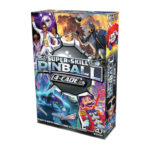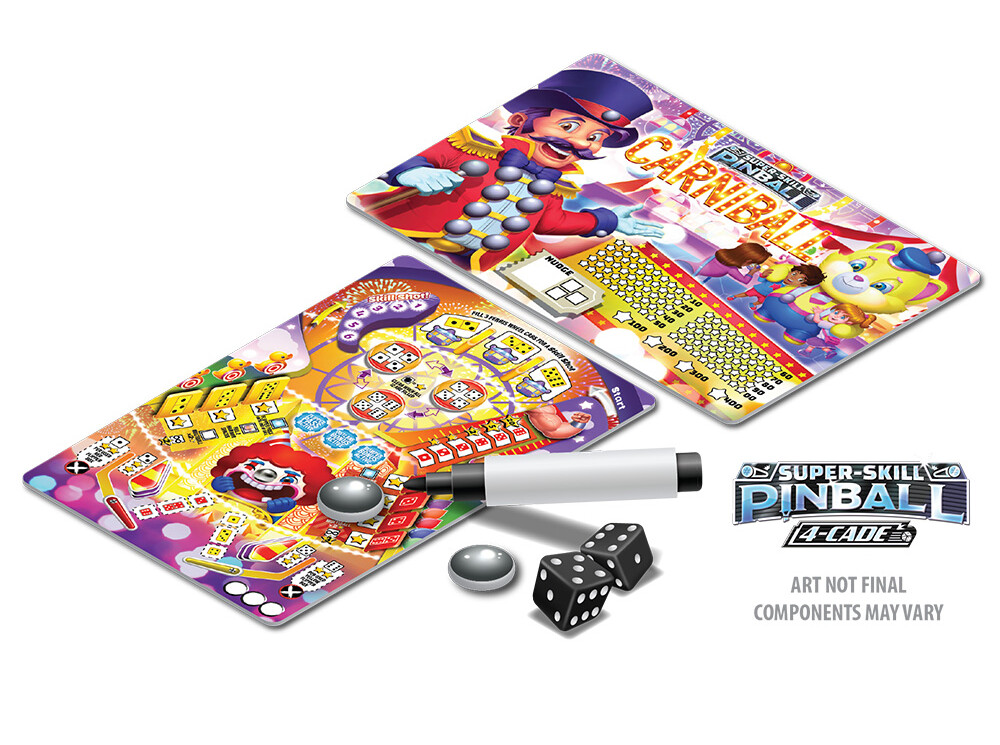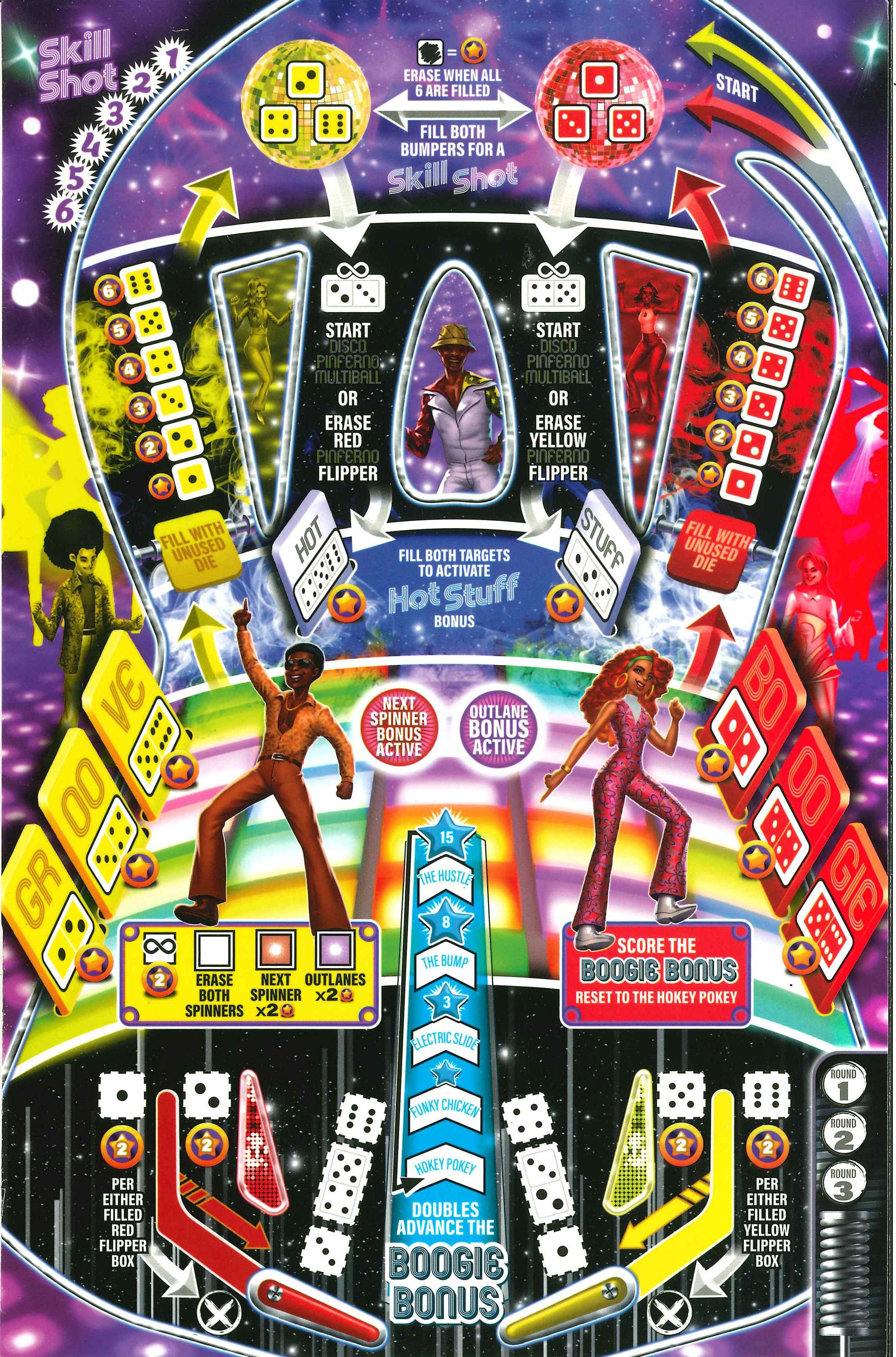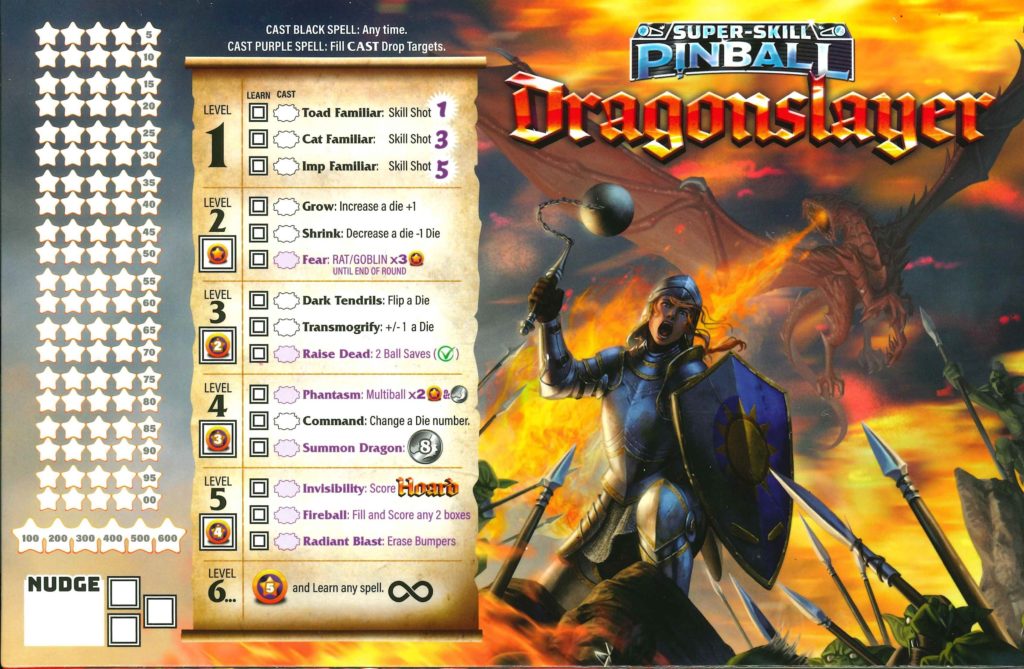Super-Skill Pinball (Boardgame)
 Super-Skill Pinball is a great example of how a boardgame’s mechanics and theme can be interwoven to produce a gaming experience that gives the “feel” of the original theme. Playing the roll and write boardgame Super-Skill Pinball: 4-Cade feels like playing a pinball. Someone rolls a pair of dice and then players use either die to record the movement of their pinball on their personal dry-erase game board, marking off locations as they are “hit.” Eventually, a player will “lose” their ball off the bottom of the board and will need to start again. After everyone has played through three balls, players total up their accumulated points to record a winner.
Super-Skill Pinball is a great example of how a boardgame’s mechanics and theme can be interwoven to produce a gaming experience that gives the “feel” of the original theme. Playing the roll and write boardgame Super-Skill Pinball: 4-Cade feels like playing a pinball. Someone rolls a pair of dice and then players use either die to record the movement of their pinball on their personal dry-erase game board, marking off locations as they are “hit.” Eventually, a player will “lose” their ball off the bottom of the board and will need to start again. After everyone has played through three balls, players total up their accumulated points to record a winner.
Super-Skill Pinball: 4-Cade
Designer: Geoff Engelstein
Publisher: Wizkids
Players: 1-4
Ages: 12+
Time: 30 min
(review copy provided by publisher)
Boardgames in the “Roll and Write” genre have a central mechanic where a set of dice are rolled and then players use them to fill in choices on their personal scorepad. These games are typically quite portable and can be played in a short time frame. As a result, the field of Roll & Write games has exploded in the past few years. While at times it seems like the genre has been over-explored, along comes something like Super-Skill Pinball to demonstrate there are always new ways to look at things.

In Super-Skil Pinball, players are aiming to score the most Stars on their player board. Play begins with a “ball” token at the top of each player’s board. Each board is covered in numerous ball locations represented by a box with a particular die value. To begin, two dice are rolled and then players choose one of them to move their ball. Balls may only move to another location that displays a box displaying the name number as their chosen die. In addition, the game board is broken into layered zones and a ball typically must also move down to a lower zone. Thus, a player’s ball will eventually end up at the bottom of their board. However, moving a ball onto one of the two bottom Flipper locations will allow players to shoot the ball back up toward the top of the board again. As play progresses, more spots are filled in, which score points, but also limit where the ball can land. When a player runs out of valid spots to move the ball, the ball is lost. Squares are then erased (some carry over) and a new ball is begun. Once the third ball is lost, players add up and bonus scores they have obtained and the player with the most stars wins the game.

Of course, moving a ball up and down a page is not a pinball simulation. Where the game shines is in how aspects of the board are used to simulate situations that might be seen in an actual pinball table. Features include Drop-Targets (hit them all to reset them and gain a special ability), Bumpers (that let you bounce between them without having to fall down a level), lighting up a set of top lane (alleys) for bonus points or abilities, and even ways to enter “Multiball” mode where you have two balls moving around at once – one for each die. For that true pinball experience, there’s also the ability to “nudge” the table to change the value of a die – with the added danger of Tilting and losing the ball entirely.
As noted in the title (4-Cade) Super-Skill Pinball contains four different possible game boards to play.
- Carniball is essentially the beginner one. It has all the basic features mentioned above, like a central set of three bumpers at the top, drop targets on the left and right, and a “feat of strength” feature on the middle right. The Feat of Strength must be completed in order (1 to 6) but it scores increasingly more points the higher you get. You get 1 star for activating the two, but 20 stars if you make it up to the six.
- Cyberhack introduces a spinner on the right side (which scores based on the die NOT chosen on that turn) and a second set of R-U-N mini-bumpers in the top left. These trigger a push-your-luck little mini-game where you earn points based on the sum of the two dice rolled, but you may lose your bonus points based on the difference of the two dice rolled. The main board even has bonuses that can be earned in order to avoid particularly bad roles during a RUN minigame. This is a nice second board. It is about as simple as Carniball, with the addition of the RUN minigame which is fairly straightforward.
- Dragonslayer models a role-playing game in that players can gain abilities and bonuses over time in order to score more and more points. Players start with a single Spell of their choice which can affect the game board. As play progresses, players can level up to learn more powerful Spells (and Rest in order to re-use them) as well as fill up the “Hoard” with silver in order to score more points for defeating the Dragon drop-targets. Dragonslayer is a fun board for experienced players who like lots of options and associated combos layered on top of the pinball game.
- Dance Fever features a second, mini pinball table, on the top card of the play area. This “Disco Pinferno” can be triggered which creates a multiball situation – with one ball on each table (top & bottom.) Players try to max out points in the top board, but can keep the upper ball in play if specific requirements are met in the bottom table. Another table better for more experienced players, especially those who like the “multiball” style of play where you must manage the numbers shown on both dice every round.

Verdict:
I am a fan of the whole roll & write idea. I like heavier games, but they are harder to get to the table given their length and complexity. Roll & Write games are shorter, less complex, and are thus easier to learn and play. With so many games out there, a new Roll & Write game needs something to stand out. The theme of Super-Skill Pinball (and how well the game models that theme) manages to make it stand out of the crowd. The four different tables add more than just variety. They provide different ways to play for different situations. Carnival is clearly the easiest to explain. However, if players want to try something different I can pick out a second table to try. Cyberhack keeps things straightforward but adds a fun new dimension in the RUN minigame. I see Dance Fever as similar, in that its mini-table serves as a sort of extra minigame. The Dragonslayer board is great for players who like to have a game with a stronger “arc” to the story and/or enjoy having lots of different abilities to use. By “leveling up” and learning new spells, a player will have more and more powerful abilities making that last ball to the table score far more than the first. Yes, the roll & write genre seems to be nearing saturation, but Super Skill Pinball manages to find something new and different to the mix, while remaining new-player friendly. While the game should appeal to a broad range of gamers, those able to appreciate the theme should find plenty to enjoy.
Kid Factor
The rules and exceptions for the game are straightforward so this is an excellent game (particularly the simpler boards, which require no reading skills) to pull out for gaming with the younger set. I’d happily go as young at 7 or 8 if a kid was interested in the game. They should be able to follow the rules correctly, even if they may not be as skilled at longer term planning.





Discussion Area - Leave a Comment